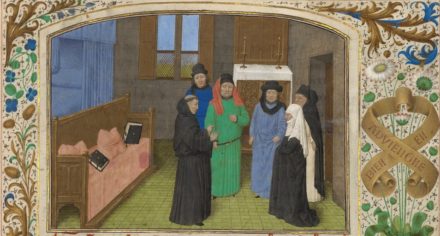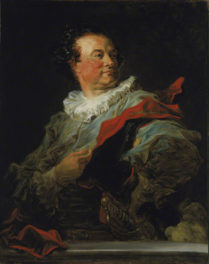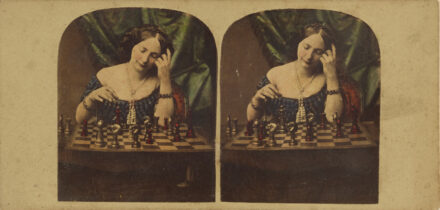
Larisa Grollemond studies pages in the manuscript Mirror of History that depicts the people of India.
Larisa Grollemond is conducting a comparative study of illuminations in the Mirror of History (Speculum historiale, Miroir historial) as a graduate intern in the Manuscripts Department of the Getty Museum. The massive text, compiled in the 1200s by friar Vincent of Beauvais and translated into French in the 14th century by Jean de Vignay, attempts to compile all of world history from creation to the present into a single source. “If our twenty-first-century way of understanding everything is to put it on the Internet,” she says, “the medieval way of understanding was to create big encyclopedic texts that try to encompass all of human history and biblical history in an organized way.”
Larisa, who recently completed her PhD at the University of Pennsylvania with a focus on 15th-century French manuscript culture, is focusing on the Getty volumes’ unique program of illuminations. The French translation of the Miroir historial exists in some 40 known copies, and while the text remains mostly unchanged from copy to copy, the illuminations vary dramatically, both in how scenes are depicted and in which episodes artists choose to depict. Larisa has decided to focus on the evolution of depictions of India and its inhabitants across these various copies, because the Getty copy, which dates to 1475, contains images that are different from earlier illuminated versions. While other copies don’t dedicate more than one or two illustrations to India, the Getty copy has several that draw upon the medieval tradition of the “monstrous peoples” as well as knowledge of geography, materials, and customs newly gained through trade.
This work ties into broader scholarly efforts to shed light on globalization in the Middle Ages. “Scholars of medieval art have generally thought of Western Europe as the center and non-European places as the periphery. There has now been a revision of that view,” says Larisa. “These manuscripts provide an interesting glimpse into how late-medieval Europeans made sense of their world, including globalization and multiculturalism,” she adds.
While only in the initial stages of her research, Larisa has already examined additional versions of the Miroir historial on a study trip to the Bibliothèque nationale de France and the Leiden University library. She has also examined many additional digital reproductions, but run into a difficulty with digitization: while libraries usually photograph each full page of a book, other institutions sometimes photograph only the illuminations, which makes it hard to understand the full context.
Ultimately Larisa plans to publish a comparative article that examines the 125-year evolution of this text and program of illuminations, but she is first interested finding additional depictions of 15th century trade (particularly between East and West) featuring textiles and other luxury materials in manuscripts, paintings, or prints. If you have resources or questions for Larisa, you can get in contact with her by email.
See all posts in this series »





Comments on this post are now closed.